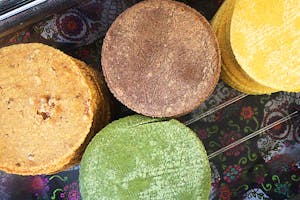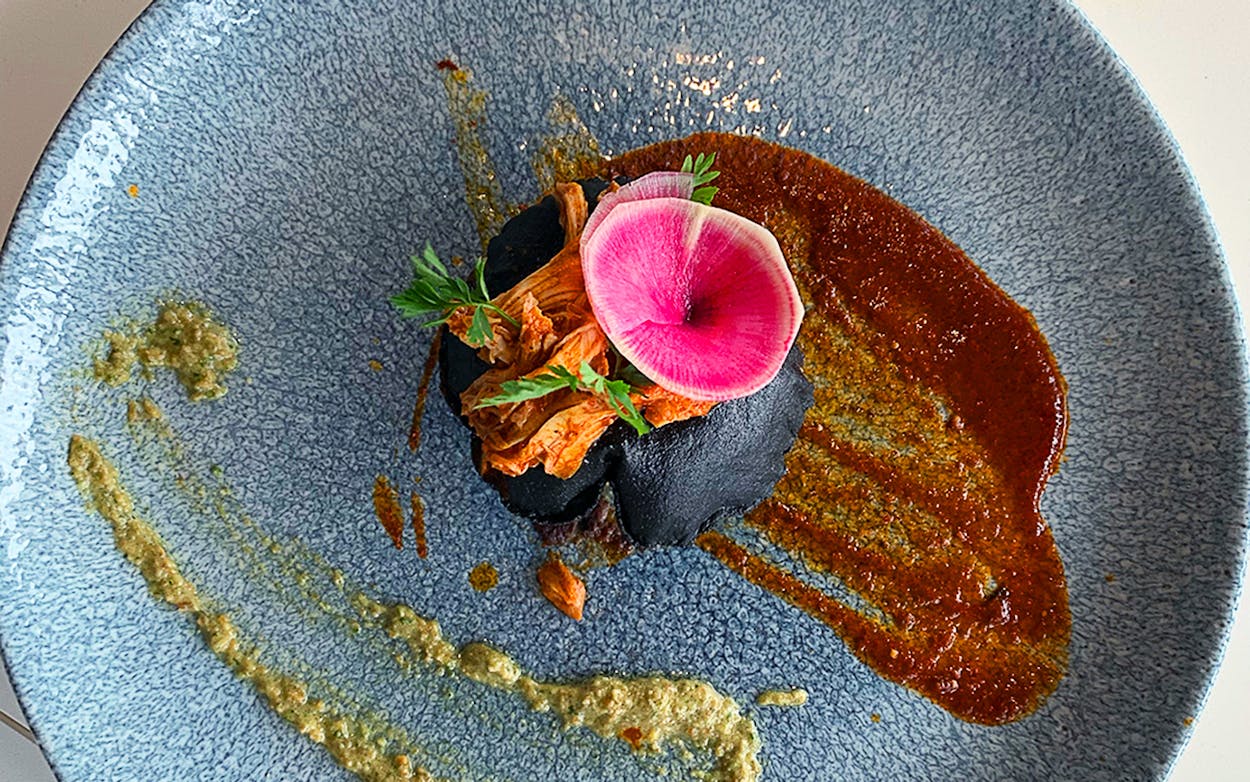Mixing ingredients into masa to create tortillas with unusual flavors or colors is a practice that goes back generations. Along the Texas-Mexico border, it’s not hard to find tacos rojos, which are made with intensely red tortillas that are traditionally colored by adding chili powder into the masa (though it’s common to use artificial coloring). Tortillas de nopales made with dehydrated and powdered cactus paddles are available throughout Mexico, as well as at tortillerias and Mexican markets in Texas. In the Mexican state of Sonora, there are garbanzo tortillas. Veracruz is known for tortillas made from a mix of corn and yuca. And now, some Texas taqueros and chefs are experimenting with even more unusual additives, further expanding the possibilities of the taco.
Anastacia Quiñones-Pittman, executive chef at modern Mexican restaurant José, in Dallas, is known for her creative infusions of purees of carrots, cilantro-poblano, Abuelita cocoa powder, almonds, and coconut milk that are the basis for her Tacos de Tacha rotating specials. For her, experimenting with additives often means reimagining an exciting entrée into a taco. Not all of those attempts have been successes, though. “We had squash blossom on the menu, so I was thinking of ingredients that go well with that and what’s in season,” Quiñones-Pittman says. “Peas were in season at the time. The radishes were beautiful. So we did squash blossom and pickled radish, and then peas go really well with truffles.” The result was a truffle-pea puree tortilla. “It didn’t work. It was beautiful as a dish. As a tortilla, no,” she says. The pureed peas dried out the masa. Still, some of her other mixtures have worked beautifully, as with the whimsical flauta taco—a short section of chicken-stuffed flauta with curlicues of crema, shredded pickled watermelon radish, and a sprinkle of chopped cilantro nestled in a black-bean tortilla that retains the legume’s flavor. It’s everything you’d find on a flauta platter but in a taco. “The ones that I have to come up with on the fly—just using the immediately available ingredients—it’s almost like a challenge for me to be more creative,” she says.
For James Beard Award-winning chef and co-owner Hugo Ortega of high-end, Oaxacan-inspired Xochi, in Houston, that sort of improvisation, based on what he’s got lying around in his kitchen, is the heart of Mexican cuisine. “It’s about using what’s around you. Seeing what you have,” he says. This is especially evident in his infladita de conejo. For the dish, squid ink is used to mimic the color of a variety of Oaxacan black corn that’s unavailable to Ortega, and it contributes a subtle balance of briny and earthy flavors. The pleasantly gritty texture of the puffed and hollowed tortilla—with almonds and raisins inside the fried masa—offsets the threads of sweet rabbit meat that spill out and over the sides. Squid ink isn’t the only infusion Ortega is playing with. “As we get inspired, you will see we have used nopales and beets to color the masa,” he says.

Meanwhile, Hector Burnias, owner of El Santuario Tacos & Cocktails, in Olmito, is serving creative tacos like alligator in a fried blue corn tortilla, buttery escargot on a spinach tortilla topped with grated parmesan, and a jerk-seasoned roasted cauliflower featuring inferno-level heat with a pineapple-habanero salsa. In a corner of Texas (the Rio Grande Valley) known for adherence to culinary tradition, Santuario is an exception. The chicken mole taco is a good example. “One of the cooks made mole. It was good, but it was kind of missing something,” he says. “When we added the chocolate corn tortilla to it, it just blew up.” The tortilla is made from chocolate boiled down and cooled until it can be mixed into masa. Burnias takes the same chocolate tortilla and deep fries it to create the taco shell for his dessert Chaco-Taco.
Taqueros and chefs like Burnias, Ortega, and Quiñones-Pittman have been infusing masa for years, and the practice is catching on—propelling tortillas in a new direction. In Austin, four-month-old Nixta Taqueria blends chile into the tortilla for the enchilada potosina taco, and at Comedor’s inaugural five-course happy hour taco tasting in January, one taco’s tortilla was infused with chile chilhuacle amarillo, resulting in a sunset-orange hued disc with hiccup-inducing spice. Gabe Erales, Comedor’s executive chef, cites giving younger cooks opportunities to play as the catalyst for the introduction of unusual ingredients into the restaurant’s tortillas. Powdered chile is perhaps the easiest component to add to masa, making for a good introduction to the practice.
Whatever ingredient is added, with the increasing popularity of augmented tortillas, a new dimension has been added to the taco landscape. The taco’s very foundation—the tortilla—is available for tinkering.








